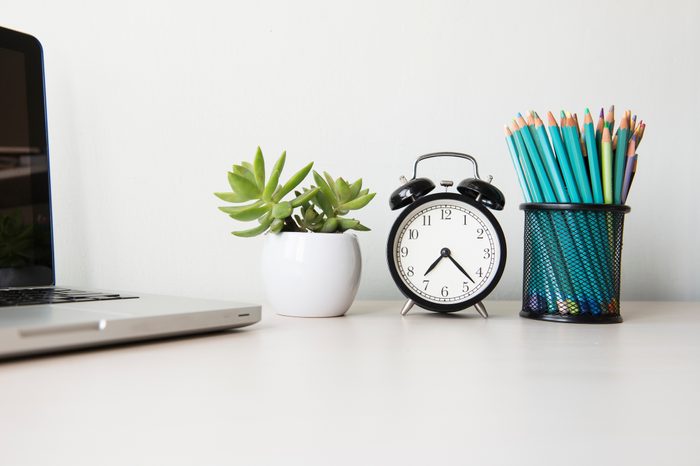
Establishing a work-life balance is important
Covid-19 has dramatically changed life for everyone. One of the most obvious changes many people have had to face is working from home every single day.
From talking to my friends, I’ve found that the general consensus is that it’s a really difficult adjustment. It’s hard to focus. Zoom conference calls are annoying. It sometimes feels impossible to find the line between work and personal life—or at least whatever’s left of it right now.
Working from home isn’t new for me. I’ve been doing it full-time since August 2019. I know firsthand how hard it can be to separate work and life when the physical boundaries are essentially nonexistent. Without an office to leave, how can you mentally distinguish between the end of the workday and the beginning of your life? It’s something I really struggled with at first, too. (Psst: Learn how a freelance writer manages her mental well-being while in self-isolation.)
It’s even harder now because there isn’t really anywhere to go, either during the workday or after. If all you’re doing is transitioning from the kitchen table or desk to the couch, it’s hard to remember why you even need to shut down your computer.
The thing is, establishing a work-life balance is essential if you don’t want to burn out quickly. Because trust me, you will. Even though you’re not going into the office, you’ll start to feel like all you do is work. It becomes all-consuming. And no one feels good when that happens.
Most remote workers learn this the hard way—I did. I struggled to find a balance for a while and felt really drained at the end of each week. But eventually, I got pretty good at officially ending my workday and transitioning into non-work life without leaving my house.
Below, you’ll find some expert-recommended tips—and my own personal go-to’s—that can help you establish a semblance of work-life balance if you’re new to working from home. (Also, welcome! It does have its perks, I promise.)

Don’t log on the second you wake up
One thing that really helps me feel like I’m not just a working machine is taking time for myself first thing in the morning. Before I log onto my computer, I make coffee and do something for myself, like enjoying a sit-down breakfast with my husband or reading a book or magazine. I’ve found starting the day this way, and then very consciously switching gears to work mode after, creates important mental separation. It also reminds me early in the day that I’m allowed to step away from work and do other things if I need or want to.
Matthew Knight, founder of Leapers, a support community for self-employed people, refers to this as a “creative commute.” Starting your morning with an activity before jumping into work “creates a very tangible ‘mental shift’ from home to work, even if you’re not physically moving between two spaces.”

Keep up your usual morning routine
“Routine is absolutely critical right now,” says Heather Monahan, entrepreneur, career expert, and author of Confidence Creator. “Finding different ways to create a routine for me and my son has been hugely beneficial. The first two weeks of quarantine, I seized the opportunity to wear sweatpants all day. But, after a while, I found that I wasn’t actually feeling that great. Now I get up, get my workout done and shower, and change my clothes as if I was leaving the house.” Try to change out of your PJs before you sit down to work. Even if you’re still wearing something comfy, like leggings—it’s just another simple way to draw a clear distinction between work time and non-work time.

Schedule regular breaks
Nancy A. Shenker, marketing expert and CEO of theONswitch, suggests blocking out times when you’re unavailable in a shared work calendar. This way your co-workers can clearly see when they can and can’t schedule meetings with you. Of course, you can’t just disappear for hours at a time and claim you’re busy. But set aside some small pockets of time so you can take care of yourself—get up to make lunch, go for a brief walk, whatever you need to do—can help you feel more in control of your work-life balance.
Personally, I block out times throughout the day for workouts, walks, and short FaceTime-breaks with friends and family. That way, not only do I stop myself from filling every single second of my time with obligations. But, I also get a calendar alert to remind me to get up and go take a break. For those of us who have a hard time straying from our calendars and to-do lists, it can be very much needed. Also, here are some ways to do self-care during self-quarantine.

Establish strict “on-duty” hours
“Turn your phone off at a certain time and let people know when you plan to be working,” Shenker adds. If you need to, you can set up an “emergency” system in case someone really has to reach you before or after your “on-duty” hours. But try to set hours and really stick to them. I find it very hard to ignore emails that pop up on my phone (I use the same phone for work and life) outside of my working hours. However, with practise, you’ll learn to only respond to anything that’s urgent. Let the rest sit until work time rolls around again.
If you have the flexibility, shift your working hours a bit to fit better with your current life. “If the 9-5 doesn’t work anymore, establish what your new working hours are,” Knight says. “I’ve found myself waking up really early, but my brain is fried by 3 p.m., so I’ve created a new working day of 7 a.m. to 2 p.m., and then use the afternoon for other activities.”

Designate one specific place as your “office”
Depending on your living situation, having an actual desk or office may not be possible. (It’s not for me, so I feel you.) But if you can, creating a space that’s dedicated to work—even if it’s just a specific corner in the living room, and not necessarily a separate room—can be helpful, says Daisy Chang, PhD, associate professor of psychology at Michigan State University. This is a great way to create some sort of physical separation between work and non-work.
If you are working from home, you might find these posture-enhancing desk stretches helpful.

Clearly set boundaries with your co-workers
“Communication of expectations is extremely important,” says Chang. “Because some of the structural boundaries are no longer there, we need to create these boundaries by figuring out what works best for each one of us, and then communicate that.”
The reality is that everyone’s situation is so different right now—we’re all dealing with many similar and many different challenges. “Be clear with your manager and your team about what your situation is, and how it is impacting what you can and cannot do,” says Knight. Openly communicating will help you both set realistic expectations and figure out a system that works well for everyone.

Collaborate with your partner
If you live with a spouse or significant other, make sure you’re aligned and ready to tackle the work week together. This will help you establish a better schedule and, as a result, work-life boundaries.
For example, if you have kids, come up with a plan for who will be on childcare duty when. Mary Beth Ferrante, HR expert and co-founder of WRK360, a platform that provides programming and personalized support for working parents, says that she and her husband sit down every Sunday night to review the week ahead. They make sure everything they know about—including work meetings, their daughters’ online learning Zoom meetings, and pre-planned video calls with family and friends—is in both of their calendars.
Each morning, they go over the day’s schedule as a family. “If both of us have a meeting at the same time that can’t be moved, we still determine who is ‘on’ and can take their call from the kitchen and keep an eye out,” Ferrante says. It’s still not easy, but working as a team definitely helps ease some of the burden.

Make after-work plans, even if they’re “plans”
It’s very easy to just keep working if you don’t have anything planned for the evening. If your only plan is to watch Netflix, you may feel guilty shutting down work when you could be getting more done (been there, felt that). I’ve found it really helps if I treat any and all “plans” like actual plans. I accept that it’s totally OK for those plans to simply be “watch Netflix.” No shame.
Pick something to do each night. Cook dinner, watch a show, work on a new skill, read a book, exercise, work on a puzzle, or whatever else you enjoy. Make dinner or movie plans (at home, of course) with your partner, or schedule virtual plans with a friend. You don’t need extravagant plans for a night out to have permission to stop working at the end of the day. A Zoom meeting with a friend or a date with yourself and The Office are completely legit, too.

Go easy on yourself
For some, work-life balance may feel like a completely unattainable goal, especially right now. Working towards it may seem pointless and anxiety-inducing—especially for anyone with young kids at home.
“There is rarely, if ever, a point of perfect equilibrium between work and family and now more than ever we need to remind ourselves that the goal should not be to find balance but to do the best we can in an impossible situation,” says Ferrante. “We may have gained back an hour or so by eliminating our commutes, but we’ve picked up the role of teacher, nanny, cook, etc. Those are hardly roles we can easily squeeze into an hour or two around our typical work hours.”
Remembering this is important, especially if balancing work, family, and you-time seems impossible. Give it your best, and accept that whatever it is, is enough.
Next, learn how to carve out more “me time” in your day.
